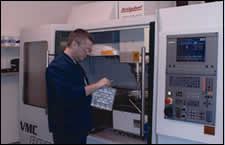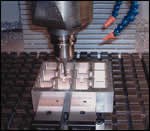CAM Software Shortens Product Development For Telecom Industry Supplier
Founded in 1972, Aerial Facilities designs and manufactures equipment for the enhancement and interference-free operation of radio communications systems.
Founded in 1972, Aerial Facilities (Chesham, Buckinghamshire, United Kingdom) designs and manufactures equipment for the enhancement and interference-free operation of radio communications systems. Its products broadly fall into two categories: active devices, such as cell enhancers that improve network coverage; and passive devices, which include filter and multi-coupling systems that enable more efficient use of the radio spectrum and single antenna working. Being able to custom design products and systems to solve particular RF problems has been the forte of the company’s success, and its engineers tend to partner with customers to develop solutions that are both practical and economic, such as installations in the Dartford Tunnel in Kent and at Heathrow Airport.
While most of the 200-person staff is engaged in the design, development and assembly of communication devices, 70 percent of Aerial Facilities’ workshop tasks are focused on development cell enhancers and a range of booster units known as duplexers and triplexers. Each prototype has to be thoroughly tested to ensure optimized performance for the environment in which it will function. These can be as diverse as international airports, underground railway systems, tunnels and all manner of buildings and industrial units.
Because many new components have to be modified or fine-tuned prior to production, in order to progressively improve their RF performance, they are frequently returned to the workshop for additional machining and adjustment. Only when a component has been fully proven and tested in the field will it be passed to a subcontractor for manufacture in production quantities.
Development work is based on the 2½-D machining of aluminium cell enhancers and duplexer or triplexer booster systems. These rectangular or square units have a matrix of profiled pockets, of which some are required on two faces with a myriad of drilled and tapped holes and various sealing grooves.
Booster components range in size from 75 mm by 50 mm by 38 mm thick up to 550 mm by 435 mm by 140 mm thick, and batch sizes average around ten. While general machining tolerances tend to be around 0.1 mm, surface finish requirements are high, at 8 microns Ra.
Manufactured from a solid aluminium billet, a typical duplexer unit involves machining between 12 or 16 pockets measuring some 40 mm square by 30 mm deep. These are closely spaced with a wall thickness of 4 mm, and most have a hollow circular post in the center. Some units are fitted with replaceable copper units that are then machined as a raised cylinder. It is the height of the walls and slot sections that is highly crucial to the performance of the RF booster. These features often have to be modified following development testing. In addition to milling, up to 80 drilled and tapped holes of M 2.5 or M 3 are required on the top face, while various countersunk holes are required in the back face of the unit. This means between four and six different setups can be required.
It was the need to speed up the manufacture of these components that led the firm to invest in new CNC machine tools and EdgeCAM off-line programming software from Pathtrace (Southfield, Michigan).
“From experience, I knew EdgeCAM was the easiest and best way to upgrade our programming because the software combines power and performance with ease of use,” says CNC programmer Ken Davis, who was largely responsible for the decision to purchase the software. “It is certainly cost-effective, very quick to set up and run and, most importantly, Pathtrace operates such a good support desk. I was not impressed with the previous CAM system, which was slow and used a variety of different windows. As the department is under constant pressure to push through development machining, in my view, EdgeCAM provided the perfect solution.”
Mr. Davis says the new system has been successful. For example, the company recently programmed a complicated duplexer that was machined from a solid block of aluminium. It had 16 pockets 40 mm by 40 mm by 30 mm deep and a wall thickness of 4 mm. It also had hollow circular posts in the center of each pocket and some 60 drilled and tapped holes.
“We were able to program the part off-line with EdgeCAM from start to finishing well under 5 hours,” says workshop team leader Steve Cyster.
The company found that there were more benefits than just simpler, faster programming, because the EdgeCAM-developed machining strategy ensured the part was completed in under 2½ hours. Because of this improvement in manufacture, which included higher confidence of what would happen on the shop floor, Aerial was able to reduce its production time on the project from several weeks to just a few days.
As a result, the recently expanded development workshop has seen leadtimes slashed by 75 percent on its program for telecoms boosters, and delivery times have also been shortened on a range of radio frequency (RF) components. With the enhanced capabilities, the workshop is able to take on certain types of production work. This helps recoup payback on the investment.
Because programming is now totally carried out using EdgeCAM, the system is DNC linked to the three CNC machines in the workshop. Prior to the Pathtrace system being installed, programming was either performed manually or through an aging CAM system.
Maximum productivity can now be gained from programming because the new machines enable more efficient cutting using special solid carbide high-helix slot drills and end mills. “On one particularly urgent job, I programmed a smaller duplexer unit from scratch, and we machined eight parts in less than 2 days,” Mr. Davis says. “We could never come anywhere near that level of efficiency or machine with such confidence with our old CAM system.”
Read Next
The Cut Scene: The Finer Details of Large-Format Machining
Small details and features can have an outsized impact on large parts, such as Barbco’s collapsible utility drill head.
Read More3 Mistakes That Cause CNC Programs to Fail
Despite enhancements to manufacturing technology, there are still issues today that can cause programs to fail. These failures can cause lost time, scrapped parts, damaged machines and even injured operators.
Read More














.png;maxWidth=300;quality=90)






